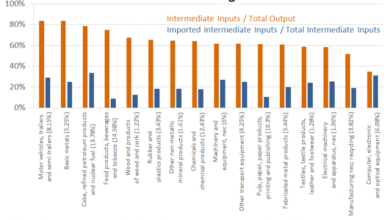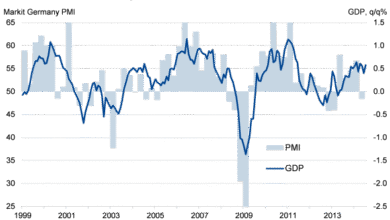Global Trade Outlook: Effects of Tariffs on Future Trade

The global trade outlook is facing a turbulent storm as recent developments, particularly the escalation of tariffs and trade policy uncertainty, cast shadows on future growth. According to the World Trade Organization (WTO), the forecast for international commerce has sharply deteriorated, sparking concerns about the ramifications of current U.S.-China trade relations. With tariffs on Chinese imports reaching up to 145%, the impact of these measures is set to ripple across diverse markets, disrupting established trade patterns. Moreover, the latest WTO global trade report highlights that a decline of 0.2% in merchandise trade is anticipated for 2025, a significant downturn from earlier expectations. As such, stakeholders must navigate the complexities of the evolving trade landscape while keeping a watchful eye on the influence of trade policies and external economic factors.
The outlook for international commerce presents a mixed landscape of opportunities and challenges, heavily influenced by shifts in trade agreements and fiscal strategies. The recent instability in trade dynamics, particularly between the United States and China, brings to light the potential repercussions on global supply chains and market competitiveness. A noteworthy decline in trade flow is expected, as indicated by the projections cited in the WTO global trade analysis. Factors such as the uncertainty surrounding tariffs and the evolving trade policy environment necessitate a recalibration of strategies for nations reliant on exports. As global interdependencies intensify, monitoring these shifts becomes imperative for all stakeholders involved in international trade.
Global Trade Outlook: A Deteriorating Landscape
The World Trade Organization (WTO) has recently issued a stark warning about the global trade outlook, emphasizing that it has deteriorated sharply due to escalating tariffs and increasing trade policy uncertainty. The latest report indicates that the volume of world merchandise trade is expected to decline by 0.2% in 2025, a significant downturn from the growth seen just a year prior. This change is attributed directly to the policy decisions surrounding tariffs, including the controversial reciprocal tariffs imposed by the Trump administration. Such developments not only alter trading dynamics but also contribute to a complex landscape fraught with unpredictability.
The reduction in trade volume, chiefly affecting North America where exports are predicted to plunge by 12.6%, underscores the severe ramifications of current trade policies. The WTO report elucidates that the declines in trade can be attributed to a ripple effect of the tariffs introduced, which have led to profound uncertainty among traders and policymakers alike. With the economic implications of these tariffs lingering on a global scale, the forecasted outlook suggests that without collaborative efforts to stabilize trade relations, further declines could exacerbate the situation, particularly for less developed countries that heavily rely on external trade.
Impact of Tariffs on Global Trade: A New Economic Reality
The imposition of tariffs has historically been a tool for countries to protect domestic industries, but the recent shifts indicate a shift in global trade dynamics that beg for scrutiny. Tariffs, particularly the reciprocal ones introduced during the past administration, have led to a drastic shift in trade relationships, especially between the United States and China. As these nations grapple with their economic disputes, tariffs have not only escalated prices for consumers but also introduced a layer of uncertainty for businesses relying on cross-border trade.
The ramifications of tariffs extend beyond immediate economic impacts. Companies are compelled to rethink their supply chains and trade partnerships, often leading to trade diversion and a reallocation of resources. As U.S. imports from China fall, other countries may seize the opportunity to fill the gaps in the market. However, this can foster increased competition among nations, thus altering long-standing trade patterns and relationships. The global economy is adapting to this new reality where tariffs play a pivotal role in shaping both opportunities and challenges.
Trade Policy Uncertainty: The New Challenge for Global Economies
Amid the turbulence of trade policy changes, uncertainty has emerged as a significant challenge for global economies. The WTO has highlighted how fluctuating tariffs and unpredictable policy decisions contribute to a climate of hesitation among businesses and investors. In an environment where trade agreements can shift overnight, companies are often left at a crossroads, unsure of how to navigate international markets. This uncertainty can stifle innovation and deter new investments, ultimately hindering economic growth.
The ripple effect of such uncertainty often manifests in reduced international collaboration and a heightened sense of risk among trade partners. Without a stable trade policy environment, nations may struggle to establish the robust economic ties necessary for sustainable growth. The underlying message from the WTO cautions that a proactive approach toward stabilizing trade relations is crucial. Building confidence through transparent policies could mitigate the adverse effects of uncertainty and foster a more conducive environment for trade.
U.S.-China Trade Relations: Navigating a Complex Landscape
The relationship between the United States and China has become increasingly complex amid tariff impositions and retaliatory measures. As one of the largest trading partnerships globally, the escalating tensions not only affect these two nations but also have profound implications for global trade dynamics. The WTO’s forecasts that U.S. imports from China will decline sharply underscore the critical shifts occurring in this relationship. The potential for significant trade diversion is becoming a prominent concern, altering how goods and services flow across borders.
Additionally, the impacts of strained U.S.-China trade relations extend to third-party countries, which could see shifts in competitive dynamics. As Chinese exports potentially increase to other regions due to reallocation of trade flows, U.S. suppliers might find new opportunities arising. However, the overarching uncertainty remains a vexing challenge, as businesses must rapidly adapt to new trade realities while considering the long-term implications of these changes on their operations and market strategies.
Merchandise Trade Forecast for 2025: Adjustments Ahead
As the WTO revises the merchandise trade forecast for 2025, a notable decline of 0.2% highlights the significant changes that have occurred due to recent tariff policies. This revision indicates a stark shift from previous growth forecasts that had anticipated continued expansion amidst improving economic conditions. The downgraded projections reflect the intertwining effects of tariffs and the accompanying uncertainties that plague global trade. Such adjustments are crucial for stakeholders to understand how new policies reshape the economic landscape.
Regional analyses are particularly telling, as North America becomes a detractor from global merchandise trade growth while Asia and Europe exhibit a contrasting influence, albeit at a reduced capacity. As the dynamics of global trade continue to evolve, parties involved in international trade must remain agile. Staying informed about forecast adjustments, economic indicators, and policy changes will be vital for effectively navigating this new terrain and optimizing trade strategies for future success.
Regional Impacts of Tariff Policies: A Global Perspective
The impact of recent tariff policies is not uniform across the globe; different regions are experiencing varying degrees of fallout from the changes. North America, notably, faces a significant downturn as exports are predicted to drop by over 12%. This stark contrast between regions underscores the necessity for policymakers to address the unique challenges posed by tariffs and trade relations. In contrast to North America, Asia’s contributions to global trade growth remain positive, though they also reflect a halving of the baseline growth expectations.
As these regional differences unfold, the WTO emphasizes that addressing tariff-induced disparities will be crucial in promoting a more balanced global trading environment. The forecast indicates that significant downside risks persist, suggesting that countries must devise multifaceted strategies to mitigate the negative effects. This may include fostering trade partnerships, exploring new markets, and implementing supportive policies that can bolster exports while securing economic stability.
Navigating Trade Diversion: Opportunities and Risks
Trade diversion resulting from tariffs poses both challenges and opportunities for nations worldwide. As U.S. imports from China decline in key sectors, other suppliers may capitalize on these market shifts, creating new pathways for trade. However, the accompanying risks must not be overlooked; while some countries stand to benefit from increased competition, others may suffer from the residual effects of trade dislocation. Understanding these dynamics is critical for developing strategies that leverage advantages while mitigating potential downsides.
Countries seeking to navigate trade diversion effectively must consider innovative approaches to integrate into existing supply chains. By fostering collaboration and establishing robust trade relationships with affected nations, they can create resilience in their exporting capabilities. The potential for increased exports to fill gaps left by reduced U.S. imports from China represents a unique opportunity that countries must strategically capitalize upon, ensuring that they remain competitive in a rapidly evolving global marketplace.
The Role of Trade Policy in Shaping Economic Futures
Trade policy serves as a fundamental pillar for shaping not only national economies but also the global economic landscape. The recent developments highlighted by the WTO serve as a reminder of how pivotal trade regulations are in influencing economic growth trajectories. With tariffs changing the nature of trade, especially in major economies, there is an urgent need for these policies to evolve in alignment with the realities of the modern marketplace. Such adaptations will be essential for fostering sustainable growth and building resilient economies.
Furthermore, countries must actively engage in dialogue to align their trade policies with the goal of minimizing uncertainty and promoting stability. Collaborative efforts that prioritize free trade can help mitigate the excesses of tariff regulations while maximizing the potential for economic growth. Ultimately, the strategic direction taken in trade policy will have lasting implications on both domestic economic prosperity and the interconnectedness of global trade relations.
Frequently Asked Questions
What is the current global trade outlook according to the WTO’s Global Trade Report?
The current global trade outlook, as reported by the WTO, indicates a sharp deterioration primarily due to increased tariffs and trade policy uncertainty. The WTO forecasts a decline in world merchandise trade by 0.2% in 2025, significantly affected by recent tariff regimes, particularly from the U.S. and trade disruptions with countries like China.
How do tariffs impact the global trade outlook?
Tariffs significantly impact the global trade outlook by creating trade policy uncertainty and disrupting export dynamics. The WTO has noted that the implementation of tariffs, particularly reciprocal tariffs, could lead to an overall decline of 1.5% in global goods trade, affecting countries less able to absorb such shocks, especially least-developed nations.
What are the potential effects of U.S.-China trade relations on global trade outlook?
The U.S.-China trade relations greatly influence the global trade outlook, with ongoing tariffs resulting in a drastic contraction in trade between the two countries. The WTO anticipates significant trade diversion; while U.S. imports from China may decrease, other regions may experience a surge in Chinese merchandise exports, complicating the overall trade landscape.
What are the forecasts for merchandise trade as per the WTO’s analysis?
According to the WTO’s analysis, merchandise trade growth is expected to decline by 0.2% in 2025, significantly influenced by the impacts of tariffs and ongoing trade policy uncertainty. This projection represents a sharp contrast to the previous growth of 2.9% recorded in 2024 and reflects heightened risks in the global trade environment.
How does trade policy uncertainty affect global trade outlook forecasts?
Trade policy uncertainty directly influences global trade outlook forecasts by creating an unstable trading environment. The WTO warns that uncertainty, particularly regarding potential reciprocal tariffs from the U.S., could exacerbate trade relations and result in a steeper decline in trade volumes, potentially decreasing global goods trade significantly.
What regions are most affected by the deteriorating global trade outlook?
North America is most affected by the deteriorating global trade outlook, with exports forecasted to drop by 12.6%. Other regions, like Asia and Europe, continue to contribute positively to trade, although at reduced levels. The disparity in impacts highlights the uneven consequences of tariff implementations and trade policy changes across various markets.
What are the implications of the WTO’s global trade outlook for least-developed countries?
The WTO’s global trade outlook implies severe challenges for least-developed countries, which rely heavily on exports. The predicted decline in global trade, heightened by tariffs and policy uncertainty, poses risks to their trade performance, as they may face increased competition and reduced market access, limiting economic opportunities.
Why is trade policy uncertainty considered a major risk in the global trade outlook?
Trade policy uncertainty is viewed as a major risk in the global trade outlook because it can lead to unpredictable changes in trade flows and market conditions. The possibility of new tariffs and trade restrictions can stifle investment and trade activity, ultimately resulting in a negative impact on global merchandise trade growth.
| Key Point | Details |
|---|---|
| Global Trade Outlook Deterioration | The WTO warns of a sharp decline in global trade due to rising tariffs and trade policy uncertainty. |
| Projected Trade Decline | Global merchandise trade is expected to decline by 0.2% in 2025. |
| Impact on North America | Exports from North America are forecasted to drop by 12.6% this year. |
| Risks to Global Trade | Possible implementation of reciprocal tariffs and broader policy uncertainty could worsen the decline to 1.5%. |
| Effects of Tariffs on U.S.-China Trade | U.S. tariffs on China have reached 145%, prompting significant trade disruptions between the two nations. |
| Trade Diversion Effects | Chinese exports are projected to rise by 4% to 9% in other regions as trade is redirected. |
| Future Trade Opportunities | The decline in U.S. imports from China opens new export opportunities for other suppliers. |
Summary
The global trade outlook has significantly worsened due to recent tariff implementations and ongoing trade policy uncertainties. The forecast anticipates a decline in merchandise trade, particularly affecting North America, with dire implications for the global economy. As countries navigate these challenges, the potential for trade diversion could reshape supply chains, offering new opportunities while heightening competition. Addressing these trade dynamics effectively will be crucial for reversing the downward trend and stabilizing international trade relations.




